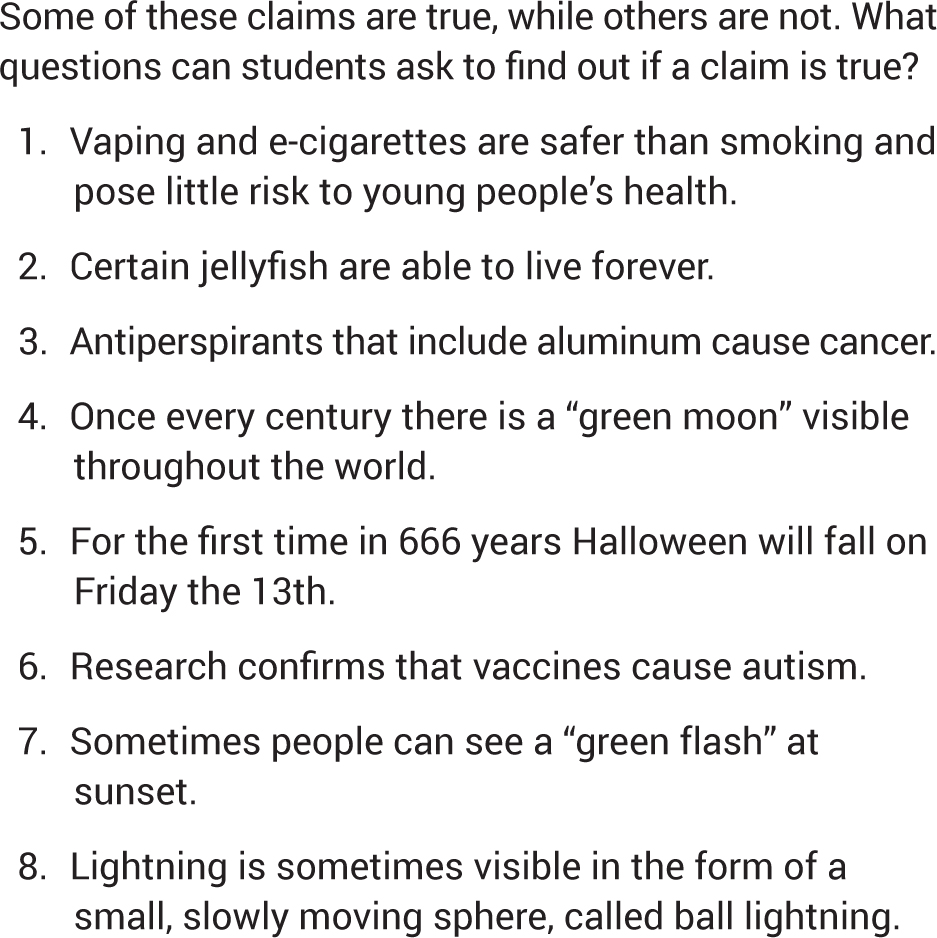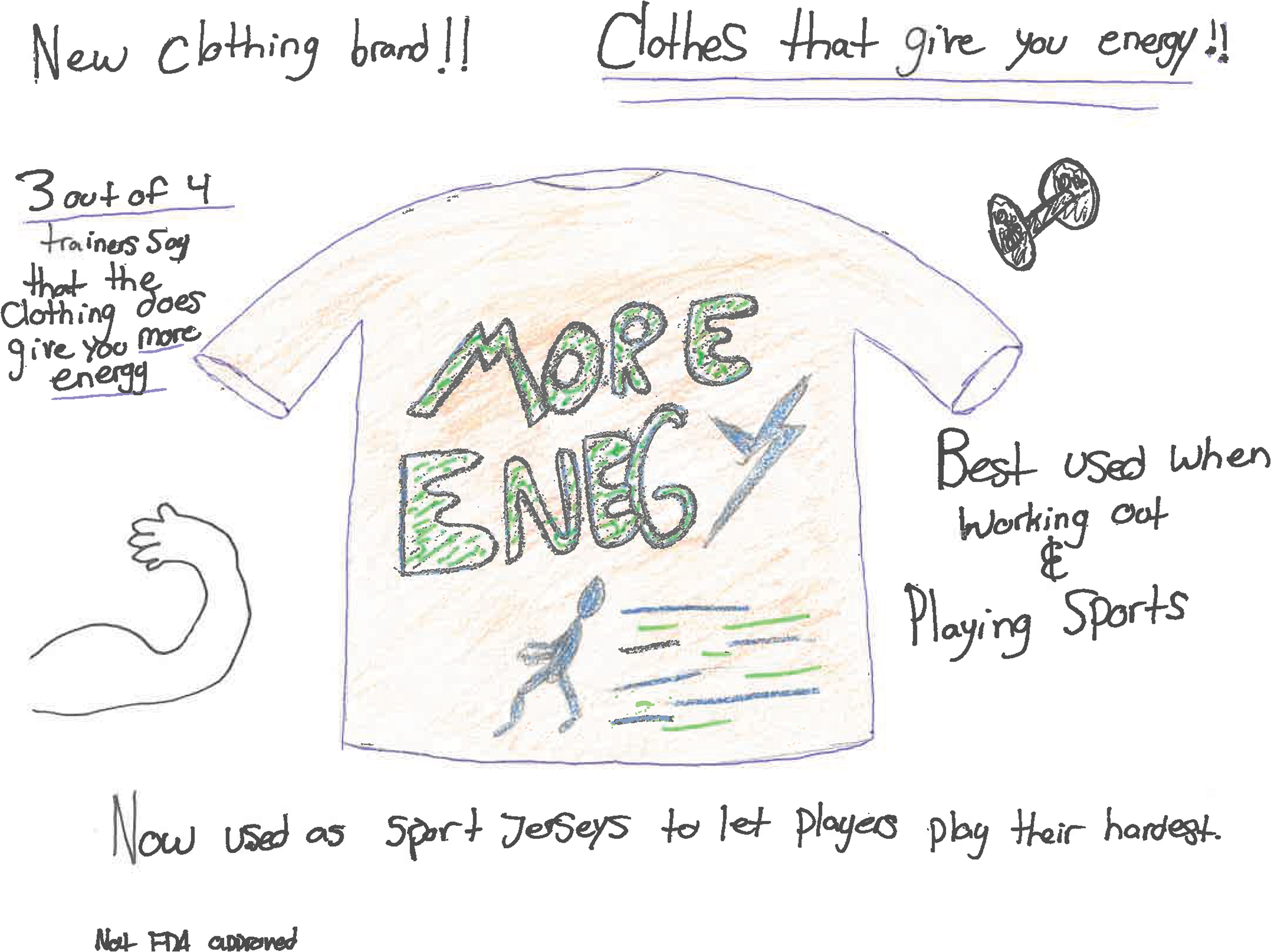Feature
Just Say No!
Teaching Students to Resist Scientific Misinformation
The Science Teacher—January 2020 (Volume 87, Issue 5)
By Andrew Zucker, Pendred Noyce, and Andrew McCullough

The United States is currently experiencing its most severe measles outbreak in decades, driven in part by parents’ belief that vaccines cause autism. That harmful misinformation is contrary to scientific evidence (DeStefano et al. 2013). The CEO of the American Association for the Advancement of Science, the world’s largest multidisciplinary scientific society, is concerned that fewer and fewer members of the public understand “the very idea that science is a special way for separating truth from falsehood” (Holt 2017). The proliferation of misinformation has become so serious that, as an editorial in The Science Teacher noted, “evidence-based reasoning seems under assault” (Metz 2017).
In response, we have developed and tested a free, research-based, one-week curriculum unit for use in grades 6–12. In the sections below we expand upon the reasons for creating the unit, describe the materials, discuss the pilot test conducted in six schools, and then indicate how the unit aligns with national education standards. This unit is aligned with both the Common Core State Standards and the Next Generation Science Standards.
Why teach students to judge the quality of “scientific” information?
As the use of social media increases—45% of teens say they are online “almost constantly” (Pew Research Center 2018)—misinformation spreads faster and further. Even as schools continue to provide accurate information to young people, science teachers now also need to teach students how to judge the quality of supposedly “scientific” information they encounter online, on TV or radio, from friends, or anywhere.
Indeed, many state policymakers are now emphasizing the responsibility of schools to teach students to separate information from misinformation. For example, in 2016 and 2017, the governor of Washington signed bills (SB 6273 and SB 5449), which focused on providing media literacy and digital citizenship education in schools. Schools usually address such topics in a social science or library class. However, reading the newspaper makes it obvious that scientific misinformation is a serious problem that requires teachers’ attention. Moreover, science—with its accepted methods for verifying new claims and building common knowledge—provides an ideal domain for honing the skills needed to be a critical consumer of information.
Moreover, social science research shows it is possible to “inoculate” people against misinformation; in other words, teachers can use experimentally tested approaches that will help students learn to separate science fact from science fiction (e.g., Cook, Lewandowsky, and Ecker 2017). The unit we describe here is based on such research. To engage students, we make use of short videos specially produced by PBS NOVA staff at WGBH, examples of colorful false and misleading advertising (a genre all too familiar to students), and the fact that young people don’t want to be fooled by lies or other misinformation (see teacher guide).
There are several other reasons it has become important to teach students how to judge the accuracy of allegedly “scientific” claims. For one thing, research shows that some people, such as climate change skeptics, accept scientific misinformation not from a lack of knowledge but from cultural polarization (Kahan et al. 2012; Kahne and Bowyer 2017) . Furthermore, there are too many false “scientific” claims for teachers to focus separately on each of them. More than ever, then, students need to be taught how to think critically about dubious claims.
In addition, studies confirm what many teachers already know: students typically are not good at searching for reliable information online. Many students are unaccustomed to questioning the first online resource they encounter, even if it is wholly unreliable. As one research group at Stanford reported after working with hundreds of students, “Overall, young people’s ability to reason about the information on the internet can be summed up in one word: bleak” (Stanford History Education Research Group 2016). Students should be taught the necessary online research skills and then practice using them.
The unit
To address these problems, this unit consists of four 45-minute lessons, plus an optional fifth lesson for teachers who want to formally assess students’ end-of-unit learning. A comprehensive teacher guide includes teaching tips and daily exit slips to use as spot formative assessments, as well as an end-of-unit student assessment with scoring suggestions. Each lesson is introduced with a short narrated video. However, during the great majority of class time, students are engaged in research, discussion, and other tasks. Like the teacher guide, the videos are available free of charge.
A fundamental assumption in this unit is that when students learn how to evaluate the quality of scientific information (the most essential part of NGSS practice 8), they “cannot comprehend scientific practices, nor fully appreciate the nature of scientific knowledge itself, without directly experiencing those practices for themselves” (NGSS Lead States 2013, p. xv). As a result, throughout the lessons teachers challenge students to explore a variety of claims, some of which are based on accurate scientific information, and others on misinformation. (In several of the lessons students need access to an internet-connected device so they can investigate claims for themselves.) The teacher guide identifies “scientific” claims for students to investigate in class as well as clarifying discussion questions teachers can pose about the claims.
Four strands, or perspectives, on misinformation are woven together in the unit. As a result, students learn how to evaluate scientific information and misinformation in multiple ways.
Strand 1: Misleading advertisements
Because research demonstrates that educating people about misleading argumentation techniques helps reduce the influence of those techniques, one perspective used in the unit is misleading advertising (Cook, Lewandowsky, and Ecker 2017), where students watch a 30-second video that was later determined by the Federal Trade Commission to be false and misleading. Students identify ways that advertising can be appealing and ways it can be misleading, and they create their own misleading advertisements based on false “scientific” claims. Tapping into their own creativity to make advertisements also actively engages students in one of the unit’s major premises—that people should not accept every “scientific” claim at face value, and should learn to judge for themselves the quality of dubious claims.
Special attention is given in the unit to a frequently recurring method used to mislead people: the argument that “the science is uncertain.” Tobacco companies used this advertising technique to undermine public understanding of the hazards of smoking, but the companies eventually paid hundreds of billions of dollars in fines for covering up the truth (Oreskes and Conway 2010). Today, climate change skeptics and deniers often use the same misleading argument.
Strand 2: Asking the right questions
Asking the right questions about a “scientific” claim is a central strand in the unit. Students explore several claims without guidance, and discuss their findings in class. Later in the unit, teachers help students identify appropriate questions to ask about dubious scientific claims to help decide whether the claims are credible. Appropriate questions to ask are similar to those used to investigate “fake news” in fields outside of science. One mnemonic to help students remember key questions is SAP, as in, “Don’t be a SAP,” where S stands for sources (Do reputable sources support the claim?), A stands for author (Who is making the claim and what expertise does he or she have?), and P stands for purpose (Is the purpose to sell something, to provoke an emotional reaction, or to provide information?).
Strand 3: Understanding science
Understanding the nature of science is a third strand. Teachers guide students to learn more about the scientific process, including how and why scientists develop confidence that their conclusions are correct, and the role that scientific and professional organizations like the Centers for Disease Control and Prevention (CDC) play. The teacher guide provides class discussion questions.
Strand 4: Reliable information
The unit also focuses on reliable sources of scientific information. For example, what are the strengths and weaknesses of Wikipedia as a source? Should students consider websites of institutions like the CDC or the Intergovernmental Panel on Climate Change (IPCC) sources of trustworthy information? Teachers guide class discussions about sources of information.
Using the four strands to examine evidence
In a culminating exercise that combines the four strands, students conduct research about how to help develop babies’ minds—including whether certain widely advertised products actually boost infants’ IQ—and write a note summarizing their findings. (Alternatively, teachers could choose to have students examine evidence about whether vaping is safe.) Identifying reliable sources, synthesizing and summarizing scientific information, and communicating clearly about one’s conclusions requires demanding skills developed in earlier lessons.
Questioning claims and locating reputable institutions
While some published lessons focus on common misconceptions about selected scientific topics such as climate change, we are not aware of other units that equip students to investigate any dubious “scientific” claim, whether about diet, cosmetics, vaccinations, or vaping. These materials encourage students to practice investigating “scientific” claims about a wide variety of topics, such as Will Mars really be as large in the sky next month as the full moon, as reported in an online post?
Another important feature is the focus on reputable institutions whose mission is to obtain, evaluate, synthesize, and communicate about science. These institutions are a vital part of the scientific process. For example, the CDC brings together experts to review scientific findings, synthesize knowledge in the field of epidemiology, make public health recommendations to policy makers, and communicate with the public about the safety of vaccinations and other health-related topics. We believe that no student should graduate high school without some understanding of the role played by such key scientific institutions as the CDC or the IPCC. As a former President of M.I.T. wrote recently in Science, one good way to “get the most from this scientific golden age” is by “recognizing the critical role of institutions in nurturing the scientific enterprise” (Hockfield 2018). Understanding how such institutions work can help students distinguish authoritative, evidence-based statements from the false mantle of authority assumed by celebrities, politicians, or others.
Teachers’ experiences
In order that the materials could be revised based on teacher feedback, the unit was pilot-tested by teachers and students in three schools and three afterschool programs, located in three states. Four of these were high schools, one was a middle school, and another was a K–8 school. Student demographics varied across schools; for example, some schools served majority minority student populations, others were more than 90% white and socioeconomically diverse, and one primarily served military families. Students in the pilot classes ranged from grades 6 through 12. In the three afterschool programs included in the pilot, PBS staff used the materials we developed, first with teachers and then with students, as part of a program to train underrepresented high school students in science communication.
Teachers provided feedback, and we used their ideas to revise the unit. For example, we added two kinds of assessment materials: daily “exit slips” that teachers can use at the end of each lesson and an end-of-unit test tied to learning goals for the four strands. We also enhanced the teacher guide with additional “scientific” claims from which teachers could choose student assignments (see Figure 1).

The first two authors of this article developed the unit, and the third taught it in the fall of 2018 and again in 2019, with several sections of mixed-ability 10th-grade biology students. These classes were “academic” and “preparatory” sections. About 20% of the students had special needs, and the students came from a variety of socioeconomic backgrounds. Differentiation was implemented throughout the lessons by requiring varying levels of research and modifying questions according to students’ needs.
The third author reports that the unit was positively received by students of multiple academic abilities. Students agreed that social media has a great influence on them and that they too readily believe what they read online. Many of his students reported finding questionable scientific claims daily in their social media feeds, while several shared stories of falling for dubious claims multiple times. At least five of his students later showed him advertisements they found that they believed were making a false scientific claim, demonstrating an unusual level of interest in the lessons. One student reported, “I now see misinformation all the time on social media and websites.”
Like other teachers, the third author reports that the initial focus on advertising was an excellent “hook” for students. A sample of student work is shown in Figure 2. He also found that after initally teaching the unit he could apply its general topic—which “scientific” claims are credible and which are not—throughout the year. During units on genetics and evolution, for example, classes discussed misinformation on sexual reproduction and human evolution in a new way, using the strategies they learned to detect bias and scientific misinformation. Students also applied their new knowledge when discussing how vaccines work. Throughout the year they enjoyed questioning bogus health claims.

Key topics for which scientific misinformation is especially relevant differ from one scientific discipline to another, and teachers can tailor the unit accordingly. For example, a high school biology teacher not involved in the pilot later reported that her students were very interested to investigate the “energy bands” people wear on their wrists allegedly to protect themselves from invisible causes of disease. To be flexible and provide teachers with more choices, we added additional examples to the teacher guide.
Conclusion
Because the lessons in this unit are flexible, teachers have an opportunity to be creative as they tailor lessons to fit the needs of their students and the particular subjects they teach. By teaching how to judge the quality of scientific claims encountered in media, teachers provide students with skills and dispositions that will serve them throughout their lives. ■
On the Web
Teacher Guide and videos: https://tumblehomebooks.org/services/resisting-scientific-misinformation/
Andrew Zucker (andyzucker@gmail.com) was a senior research scientist at the Concord Consortium in Concord, Massachusetts. Pendred Noyce is the executive director at Tumblehome Books in Boston, Massachusetts. Andrew McCullough is a science teacher at Brunswick High School in Brunswick, Maine.
Literacy News Teaching Strategies High School


